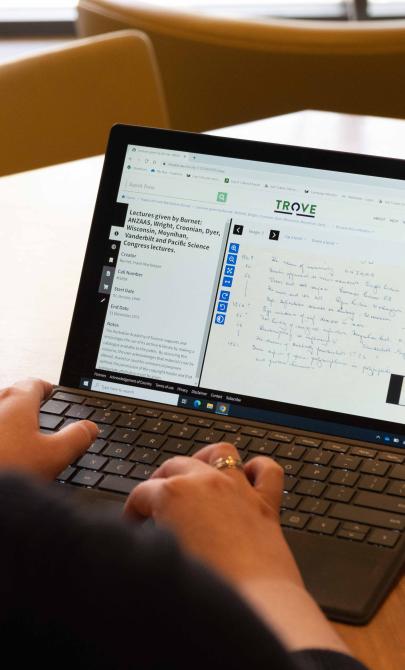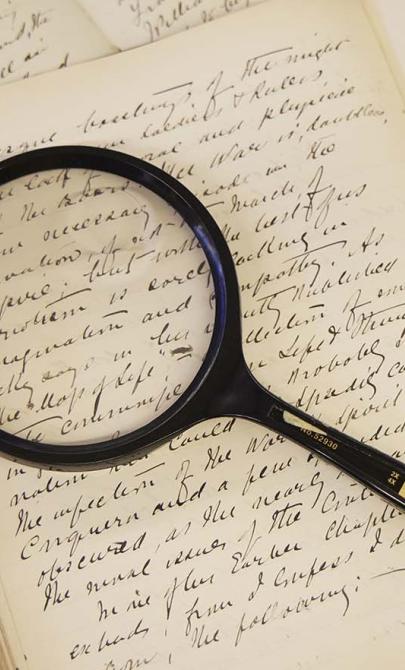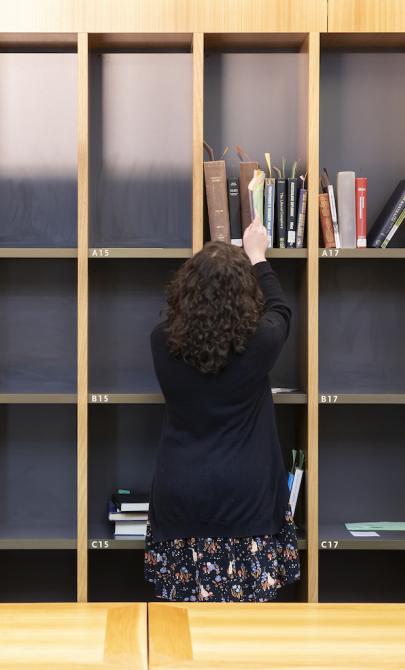Petherick Collection
Key items in the collection
Highlights from this collection demonstrate its historical significance and variety.
The Petherick Collection is one of the largest collections ever acquired by the Library, but there is considerable uncertainty about its exact size. Petherick himself was rather cavalier in his use of statistics and, despite his skills as a cataloguer, he did not compile a catalogue of his own collection. His books were not kept together as a formed collection and the catalogue cards were also integrated into the general catalogues, making it very difficult to establish the precise size of the collection. It seems likely that there are about 15 000 books and pamphlets, but the number may be a good deal higher.
The great strength of the collection is in Pacific voyages and early Australiana. They include the first editions of the voyages of William Dampier, George Anson, Louis de Bougainville, James Cook and George Vancouver, and the foundation texts by Arthur Phillip, Watkin Tench, John Hunter, John White and David Collins. Perhaps more significantly, there are works that are extremely rare or even unique, in the sense that no other copies are known to have survived. The following are a few examples of rare works in the collection:
- An Account of the English Colony at Botany Bay (1808)
- An Authentic Journal of the Expedition Under Commodore Phillips to Botany Bay(1789)
- Barrington, George, Barrington’s Voyage to Botany Bay (1801)
- Bligh, William, William Blighs, Kapitains von der Grossbrit. Flotte, Reise in das Sudmeer, welche mit dem Schiffe Bounty unternommen worden ist … (Berlin, 1793)
- Dalrymple, Alexander, An Account of the Discoveries Made in the South Pacifick Ocean (1767)
- Marra, John, Journal of the Resolution’s Voyage, in 1772, 1773, 1774, and 1775, on Discovery to the Southern Hemisphere … (1775)
- Dalrymple, Alexander, A Serious Admonition to the Public on the Intended Thief-colony at Botany Bay (1786)
- Proposals for Employing Convicts within this Kingdom (1787)
- Entrecasteaux, Antoine Raymond Joseph de Bruni, chevalier d, Voyage de Dentrecasteaux, envoyé à la recherche de la Pérouse (2 vols, 1808)
- Flinders, Matthew, Observations on the Coasts of Van Diemen’s Land, on Bass’s Strait and its Islands and on Part of the Coasts of New South Wales (1801)
- Forster, Georg, Letter to the Right Honourable the Earl of Sandwich, First Lord Commissioner of the Board of Admiralty (1778)
- Johnson, Richard, An Address to the Inhabitants of the Colonies Established in New South Wales and Norfolk Island (1794)
- Ledyard, John, Journal of Captain Cook’s Last Voyage to the Pacific Ocean, and in Quest of a North–West Passage Between Asia & America … (1783)
- Lewin, John, Birds of New Holland (1808)
- Mann, D.D., The Present Picture of New South Wales (1811).
The books relating to Australia, New Zealand and the Pacific in the Petherick Collection date from about 1700 to 1915. Petherick did not specialise in any subject fields and, while a few outstanding items were beyond his means, his collection is remarkably comprehensive. His collection of 3048 pamphlets is arranged by subject and the main subject headings illustrate the breadth of his Australiana collection as a whole:
Aborigines, Agricultural and industrial, Australian politics, Banking, Biography, Botany, Defences, Dutch voyages, Education, Emigration, Exhibitions, Exploration, Fiji, Fine arts, Geology and mining, Imperial federation, Land question, Legal, Literary, Music and drama, New Guinea, New South Wales, New Zealand, New Zealand Wars, New Zealand islands, Northern Territory, Pacific Islands, Public health, Public works, Queensland, Religion, Sacred music, Science, Ships’ newspapers, Slavery, South Australia, Statistics, Steam navigation, Tasmania, Trade and commerce, Transportation, Trials, Victoria, Voyages, Western Australia, Zoology.
The non-Australian component of the collection consists of approximately 4000 books, mostly in English, published between about 1600 and 1915. Among the earliest works are about 50 editions of imaginary voyages to Terra Australis Incognita, beginning with Joseph Hall’s Mundus alter et idem (1605). While the principal strength is literature, the subject range of the overseas books is again very broad. They include English literature, American literature, European literature, language, Greek and Latin classics, ancient history, medieval history, British history, history of the British Empire, American history, European history, biography, travel, sociology, political thought, economics, music, art, architecture, printing, religion, religious history, philosophy, ethics, astronomy, botany, bibliography and libraries. The great bulk of the works date from the nineteenth century, but a significant number were published in the seventeenth and eighteenth centuries.
The collection contains about 120 volumes of publications of the Hakluyt Society, published between 1847 and 1910. There are also long sets of the serials:
Probably the most important group of manuscripts in the Petherick Collection are the papers of Sir Joseph Banks, which Petherick bought at auction in 1886. They include the drafts of Banks’ petitions to the Viceroy of Brazil (1768) and his ‘Thoughts on the manners of [the women of] Otaheite’, the Earl of Morton’s ‘hints’ on dealing with indigenous peoples, and a manuscript catalogue of drawings by John Webber. There are also letters written to Banks by Arthur Phillip, John Hunter, Matthew Flinders, David Collins, Philip Gidley King and other notable figures in the early years of the Australian colonies. Other early Australian manuscripts include the journal of King at Norfolk Island (1791–96), the journal of Archibald Menzies, the naturalist on HMS Discovery (1793–94), the journal of James Colnett on HMS Glatton (1803) and the manuscript of the poem Australasia by W.M. Praed (1823).
The oldest item in the Petherick Collection is a fourteenth-century English psalter, with a contemporary binding. There is also a remarkable collection of letters and autographs by distinguished British, European and American figures such as Jane Austen, Charles Darwin, George Eliot, W.E. Gladstone, Lord Nelson, John Ruskin, William Thackeray, Mark Twain and the Duke of Wellington. Another series consists of miscellaneous documents of the eighteenth and nineteenth centuries, including a few relating to Australia and the Pacific.
Petherick himself was a prolific creator of manuscripts. They range from his transcripts of documents on early Pacific voyages to drafts of his articles, bibliographies and autobiographical notes. The most important single manuscript is his ‘Bibliography of Australasia’, comprising tens of thousands of entries on handwritten slips of papers or extracts from catalogues, arranged under broad subject headings. Extending from the sixteenth century to the early twentieth century, it incorporates journal and newspaper articles as well as books.
Maritime exploration was one of Petherick’s great interests and he assembled a strong collection of atlases and maps. Important examples are atlases of Abraham Ortelius (1601), Hendrick Doncker (1659) and Peter Goos (1669), and world maps of Jodocus Hondius (1634), Willem Blaeu (c. 1635), Henricus Hondius (1636), Philippe Buache (1740–55) and Thomas Kitchin (1795). There are about 185 sheet maps of Australia, New Zealand and some of the Pacific Islands. They include the two earliest Dutch maps of Western Australia by Hessel Gerritsz, published in 1627–31, both of which are extremely rare. Later works include charts of British and French hydrographers and maps of the colonies by Aaron and John Arrowsmith, Edward Stanford, James Wyld and other London cartographers. All the colonies are represented, with general, road, railway and goldfields maps of Victoria forming the largest group.
Within the collection are some extremely important manuscript maps. Two maps by Isaac de Graaf, dating from about 1701, are based on the explorations of the Western Australian coast and Rottnest Island by Willem de Vlamingh. Among the maps of surveyors are two manuscript maps of Tasmania by G.W. Evans, drawn in 1819–20.
Petherick only occasionally acquired paintings and drawings, but there are about 150 works in his collection. They include sketches of South Sea Islanders by William Hodges (c. 1773), drawings of Indians at Nootka Sound by John Webber (1778), a group of watercolours of Sydney by Edward Dayes (c. 1797), watercolours of Australian Aborigines by Richard Browne (c. 1819), pencil sketches of Sydney and other subjects by Conrad Martens and a watercolour of Geelong by William Tibbits (1875). The most significant group comprises 44 pen and wash drawings of scenes in New South Wales and Tasmania, painted in 1843–45 by John Skinner Prout.
There are many hundreds of wood engravings, line engravings, aquatints, lithographs and other prints in the Petherick Collection. Among the earliest are works by the Cook artists Hodges and Webber and by artists on French exploring voyages such as Charles Lesueur, Romuald Ménard and Nicolas-Martin Petit. The bulk of the Australian and New Zealand prints date from the 1820s to the 1860s. There are numerous works by S.T. Gill, Nicholas Chevalier, Eugene von Guerard and John Skinner Prout. Other artists represented in the prints collection include George Fife Angas, François Cogne, Joseph Fowles, Charles Heaphy, Joseph Lycett, Augustus Prinsep and Robert Westmacott.
Although not extensive, the personal papers of Petherick document the various phases of his life from his childhood in Melbourne until his last years when he was working in the Commonwealth Parliamentary Library. They include family papers, correspondence, scrapbooks, notebooks, addresses, manuscripts, newspaper cuttings and printed ephemera. An important source on his early life are the letters that he wrote regularly from London to his father in Melbourne (1870–77). There are very few papers on his collecting activities, but a good deal of material on the presentation of the collection to the Commonwealth in 1909–11. Other papers relate to Petherick’s historical research and writings and his association with the York Gate Library, the Matthew Flinders Memorial Statue Committee, the Library Association of Victoria and the Royal Geographical Society of Australia.
About Edward Petherick
Edward Augustus Petherick (1847–1917) was born in Burnham, Somerset, the son of the village postmaster and bookseller. The family emigrated to Melbourne in 1852 and Edward grew up in Collingwood, where he attended a local public school. In 1862 he joined Robertsons, the bookselling and publishing firm that dominated the wholesale book trade in Australia. In 1870 George Robertson sent Petherick to London, where he was to live for nearly 40 years. He soon became the Home Manager of Robertsons, selecting books for shipment to the Australian colonies. He resigned in 1887 and set up his own business, the Colonial Booksellers’ Agency. Its head office was in London and it had branches in three Australian cities. Petherick also entered publishing, producing such series as Petherick’s Collection of Favourite and Approved Authors and Petherick’s Collection of Popular European Authors. However, his business collapsed and he was declared bankrupt in 1894. His wife and friends came to his aid and within a few years he gained employment as a cataloguer with the leading antiquarian bookseller Francis Edwards. He returned to Australia in 1909.
Petherick had a strong interest in maritime exploration and the history of Australia and New Zealand. He was a member of the Royal Geographical Society, the Hakluyt Society and the Royal Colonial Institute and was acquainted with many historians, geographers, travellers and collectors in London. In 1883–85 he wrote a series of long articles on early European exploration in the Pacific and he returned to this subject in later years. As a young man in Melbourne he had started compiling bibliographies and his training as a bookseller and his enthusiasm for history led him to produce catalogues and bibliographies of exceptional quality. His Catalogue of the York Gate Geographical and Colonial Library, published in 1882, was a fine record of one of the earliest private collections of Australiana. He worked on his ‘Bibliography of Australasia’ for most of his life and it eventually contained about 100 000 entries, but it was never published.
Petherick claimed that it was his work on the ‘Bibliography’ that led him to start collecting books, manuscripts, maps, prints and paintings on Australia and the Pacific. The major part of his collection was assembled in London in the period 1879–94, although he continued to collect books and pamphlets until the last years of his life. He was not a wealthy man, but he was collecting at a time when prices for accounts of voyages or early books on the colonies were extremely modest. Moreover, he was at the right place at the right time. London had numerous antiquarian bookshops and great auction houses and, with the onset of agricultural depression, many aristocrats and other landowners were disposing of their large private libraries.
After the Commonwealth acquired the collection in 1909, Petherick was paid an annuity and worked in the Commonwealth Parliamentary Library for seven years. He also assembled and catalogued the library of the Governor-General. He was awarded the CMG in 1916.
Background to the collection
Petherick first offered his collection as a gift to the new Australian Commonwealth in March 1901, but the offer was ignored. In January 1909 he arrived in Melbourne and his collection was displayed in the Royal Exhibition Building, where it was inspected by the Prime Minister, the Speaker and the Parliamentary Librarian. In November 1909 an agreement was signed transferring ownership to the Commonwealth, appointing Petherick as Archivist, and paying him an annuity. The agreement was confirmed by Parliament in the 1911 Petherick Collection Act. Following the death of Petherick in 1917, many more books, prints, manuscripts and personal papers were received from his executors.
With the exception of the pamphlets, the books and other publications in the Petherick Collection have not been kept together but instead have been integrated in the Australian, Rare Books and general collections. All the works have an embossed stamp on the title page and many have the initials EAP on the spine. The works have entries in the Library’s online catalogue, although they only occasionally give the provenance of the works. A card catalogue covering a large part of the collection is held and an accession register listing the overseas books is located in the Manuscripts Collection. The Petherick Bibliography often indicates that Petherick owned a copy of the title listed.
The maps in the Petherick Collection are dispersed among the rare maps in the Maps Collection. The maps are embossed with the Petherick stamp. The paintings, drawings and prints are held in the Pictures Collection, but again they have not been kept together as a collection. They have mostly been catalogued individually, but it is generally necessary to consult the accession registers to establish the provenance of the works.
The manuscripts and personal papers are held in the Manuscripts Collection and the Petherick Bibliography, which is contained in 92 boxes, is shelved in the Manuscripts Reading Room. This includes the papers of Sir Joseph Banks, journal of Philip Gidley King, journal of Archibald Menzies, journal of a voyage round the world in his Majesty's ship Glatton and Illuminated Psalter. Miscellaneous manuscripts, together with transcripts and the autograph collection, are kept with Petherick’s personal papers.
The York Gate Library, which Petherick catalogued in 1882–86, was acquired by the Royal Geographical Society of South Australia in 1905. It is now located in the Mortlock Wing of the State Library of South Australia. A catalogue of the manuscripts in the library is available online.
This guide was prepared using these references:
- Biskup, Peter, Edward Augustus Petherick and the National Library of Australia, 1909–1917, in Peter Biskup and Maxine Rochester (eds), Australian Library History: Papers from the Second Forum on Australian Library History, Canberra College of Advanced Education, Canberra, 1985, pp. 75–99.
- Burmester, C.A., Petherick, Edward Augustus (1847–1917), Australian Dictionary of Biography online
- Osborn, Andrew and Margaret, The Commonwealth Parliamentary Library 1901–27 and the Origins of the National Library of Australia, Department of the Parliamentary Library, Canberra, 1989.
- Powell, Graeme, The Great Bookmen: E.A. Petherick and J.A. Ferguson, in Peter Cochrane (ed.), Remarkable Occurrences: The National Library of Australia’s First 100 Years 1901–2001, National Library of Australia, Canberra, 2001.



